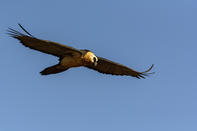Up and Away
Vultures use thermals to facilitate low-energy flight. Pockets of rising warm air form when the sun heats the ground during the day and these thermals provide lift to the enormous birds.

Vultures are equipped with enormous wingspans of up to 2.8 m, in Lappet-faced vultures, which suit this style of flight.
Using thermals prevents the necessity to flap these large wings and thereby the birds save more than three times the energy that would be needed in flapping flight. Vultures use thermals to gain a height vantage to look for food and by moving from one thermal to the next they can survey vast areas while foraging.
Vultures can soar at altitudes up to 12000 m, covering thousands of kilometres at a gliding speed of about 60 kmph but up to 80 kmph. Vultures are restricted to flying during the sunny hours of the day and at night and on overcast days generally, find themselves grounded.
Circling Vultures
White-backed vultures forage using a grid flight pattern. By circling in an organised manner, one bird can see when another breaks the formation. If an individual spots something and starts to move downwards, its white back offers an obvious beacon to the other birds that follow suit.
Vultures will also watch for other lower-flying species of vultures (like the white-headed vulture) descending on a kill or scavenging raptors like the Tawny and Bateleur eagles. They even follow lions and hyenas sometimes.
Vultures have been recorded as achieving diving speeds of 120 kmph as they literally ‘fall’ out the sky upon a meal. It is this spectacle of vultures dropping quickly out of the sky in an isolated area that indicates to an observer, the presence of a kill. Many people get excited on seeing vultures circling but this is their usual foraging style and in most instances, they are merely catching thermals.
By Megan Emmett